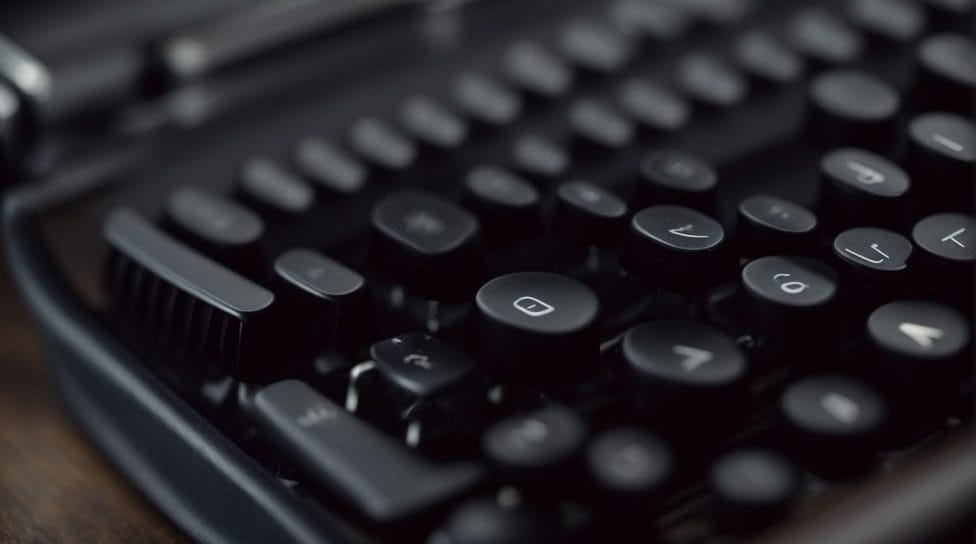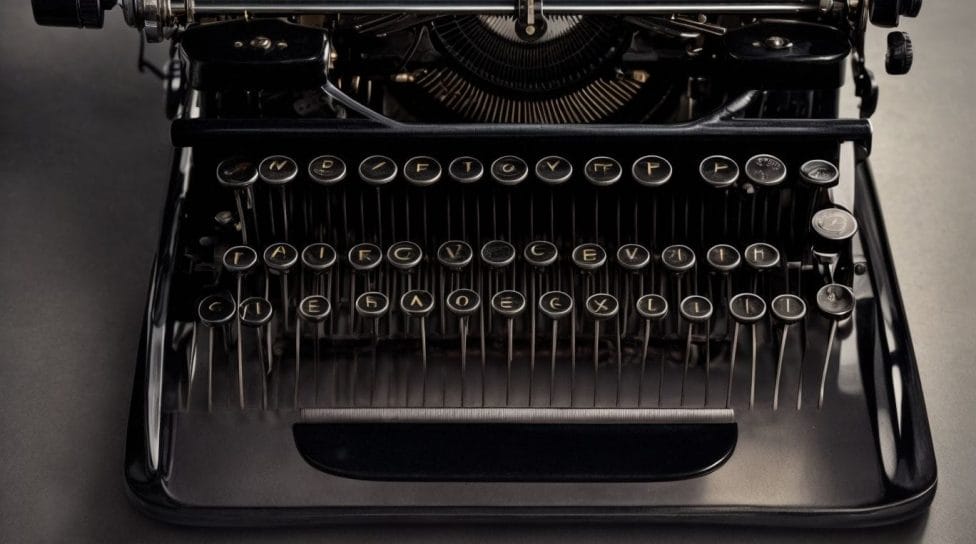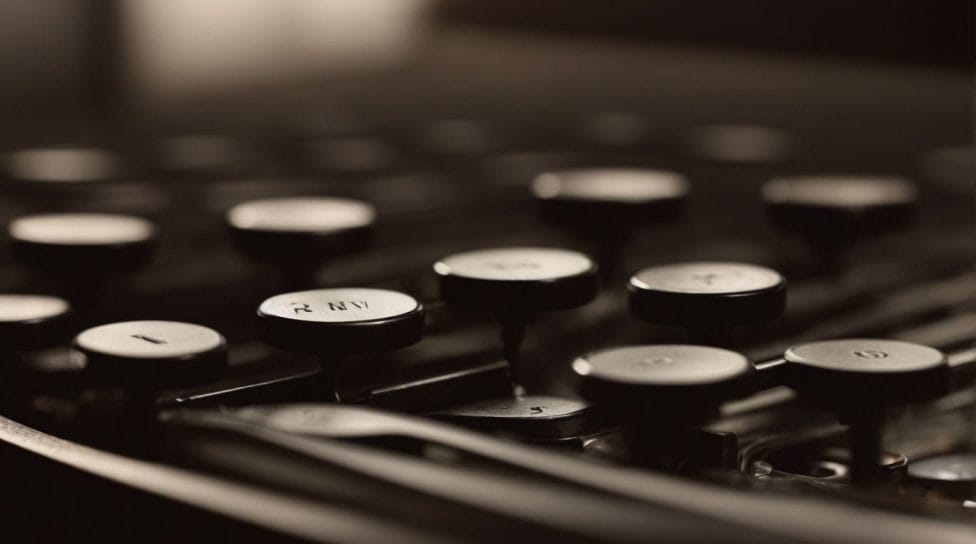The typewriter is a revolutionary invention that transformed how we write and communicate. In this article, we will explore the intriguing history of typewriters, from early writing instruments to the inventors who revolutionized writing technology.
The evolution of typewriters can be traced back to the need for a more efficient and mechanical writing device. Before typewriters, people used various tools and instruments to write, such as quills and ink pens. However, these tools were time-consuming and often resulted in messy and illegible writing.
The invention of the typewriter can be attributed to several pioneers who contributed to its development. One of the key figures in typewriter history is Christopher Latham Sholes, who is widely recognized as the primary inventor of the typewriter. Alongside Sholes, Carlos Glidden and Samuel W. Soule played crucial roles in refining the typewriter design.
The first commercially successful typewriter, the Sholes and Glidden typewriter was introduced to the market in the late 1860s. This typewriter featured a QWERTY keyboard layout, which has since become the standard layout for typewriters and computer keyboards.
The QWERTY keyboard layout was designed to address the limitations of early typewriters, which often experienced jamming issues due to fast typing. The arrangement of the keys in the QWERTY layout was intended to minimize the likelihood of key jamming by placing frequently used letters apart from each other.
Although alternative keyboard layouts have been proposed over the years for increased typing efficiency, the QWERTY layout has endured and remains the most widely used layout.
The impact of the typewriter on writing and communication cannot be overstated. The typewriter significantly increased efficiency and speed in producing written documents, leading to greater productivity in various fields. However, with the advent of computers and word processors, typewriters have gradually become obsolete.
Today, we can witness the legacy of the typewriter in the keyboard layouts we use on our computers and devices. While the typewriter may no longer be the primary tool for writing, its influence and contributions to writing technology continue to shape how we communicate in the digital age.
Key takeaways:
- The typewriter was invented by Christopher Latham Sholes, Carlos Glidden, and Samuel W. Soule. These pioneers of typewriter development collaborated to create the first commercially successful typewriter.
- The QWERTY keyboard layout was designed to prevent jamming: The purpose of the QWERTY layout was to place frequently used letters apart to avoid mechanical jams, common in early typewriters.
- The typewriter revolutionized writing and communication: With the invention of the typewriter, writing became more efficient and accessible, leading to increased productivity in offices and the eventual transition to computer-based typing.
The Evolution of Typewriters

Photo Credits: Loststorystudios.Com by Bradley Brown
In the fascinating world of typewriters, we delve into the evolution of these marvelous writing machines. Discover the early writing instruments that paved the way for the invention of the mechanical typewriter, as well as the need that drove the creation of this revolutionary device. Brace yourself for a journey through time as we uncover the intriguing story behind the evolution of typewriters. Get ready to be captivated by the birth of a transformative writing tool that forever changed how we put thoughts on paper.
Early Writing Instruments
Early writing instruments were crucial tools for communication and record-keeping. Below are some examples of early writing instruments:
- Quills and Reeds: These were commonly utilized in ancient civilizations such as Egypt and Rome.
- Papyrus: Egyptians employed this plant material to establish a writing surface.
- Wax Tablets: Popularized by the Greeks and Romans, these were wooden tablets covered with wax, where markings could be made.
- Clay Tablets: In Mesopotamia, these tablets were impressed with characters using a stylus.
The Need for a Mechanical Typewriter
The need for a mechanical typewriter arose from several factors, including the increasing demand for faster and more efficient writing methods. Before typewriters, writing instruments like quills and pens were time-consuming and prone to errors. The need for a more precise and legible writing tool led inventors to develop the first mechanical typewriters. These early machines offered typists a way to fulfill the need for a mechanical typewriter by producing documents quickly and accurately, revolutionizing the writing process. One true story that reflects the need for a mechanical typewriter is the case of Mark Twain, who struggled with handwriting and found the typewriter to be a game-changer in improving his productivity.
Invention of the Typewriter

Photo Credits: Loststorystudios.Com by Roger King
Discover the fascinating origins of the typewriter as we dive into the history of its invention. Uncover the visionary pioneers who played a pivotal role in developing this revolutionary writing machine. From their tireless efforts emerged the first commercially successful typewriter, forever changing the way people communicate and record information. Join us on this journey of discovery as we explore the remarkable journey of the typewriter’s invention.
The Pioneers of Typewriter Development
“` The Pioneers of Typewriter Development
Christopher Latham Sholes, Carlos Glidden, and Samuel W. Soule pioneered typewriter development. They played crucial roles in inventing and improving the typewriter.
| Pioneer | Contribution |
| Christopher Latham Sholes | Created the first practical typewriter, the Sholes and Glidden Typewriter |
| Carlos Glidden | Collaborated with Sholes in refining and enhancing the typewriter design |
| Samuel W. Soule | Contributed to the development and improvement of the typewriter |
Their collective efforts led to the creation of the first commercially successful typewriter. Their inventions revolutionized writing and communication, paving the way for increased efficiency and productivity. As a result, typewriters became widely used tools for professionals and individuals alike.
Suggestions for further reading on the topic:
- “The History of Typewriters: From Invention to Modern-Day Keyboards”
- “Exploring the Innovations and Advancements in Typewriter Technology”
The First Commercially Successful Typewriter
The first commercially successful typewriter, known as the Sholes and Glidden typewriter, was invented by Christopher Latham Sholes in the late 1800s. The table below provides key details about this groundbreaking invention:
| Inventor | Christopher Latham Sholes |
| Year of Invention | The late 1800s |
| Type of Typewriter | Mechanical typewriter |
| Commercial Success | The first commercially successful typewriter |
Key Inventors and Their Contributions

Photo Credits: Loststorystudios.Com by Dennis Anderson
Discovering the brilliant minds behind the invention of the typewriter is like unveiling a treasure trove of innovation. In this section, we will delve into the fascinating world of key inventors and their contributions. Brace yourself to embark on a journey with Christopher Latham Sholes, Carlos Glidden, and Samuel W. Soule. Each of them has left an indelible mark on the history of the typewriter, shaping the way we communicate and revolutionizing the world of writing. Get ready to be amazed by their ingenuity and visionary thinking!
Christopher Latham Sholes
Christopher Latham Sholes, a skilled inventor, played a vital role in developing the typewriter. He is credited with creating the first practical typewriter that was commercially successful. Sholes, along with his team members Carlos Glidden and Samuel W. Soule, patented the typewriter design in 1868. His invention included the QWERTY keyboard layout, designed to prevent typewriter jamming. Christopher Latham Sholes’ contribution to the typewriter industry revolutionized writing and communication, increasing efficiency and paving the way for the transition to computer-based typing.
Carlos Glidden
Carlos Glidden was a pivotal figure in the development of the typewriter. His partnership with Christopher Latham Sholes and Samuel W. Soule led to significant advancements in typewriter design. Glidden played a crucial role in the invention by developing the prototype and enhancing its functionality and efficiency. Notably, he actively participated in improving the keyboard layout, and it was his contributions that eventually resulted in the widely used QWERTY layout still in use today. The profound impact of Glidden’s contributions to writing and communication within the typewriter industry cannot be understated. Through his collaboration with Sholes and Soule, Glidden paved the way for heightened typing efficiency and played a pivotal role in facilitating the shift to computer-based typing.
Samuel W. Soule
| Samuel W. Soule | Contributions |
| Samuel W. Soule | Played a crucial role in the invention and development of the typewriter. |
| Collaboration with Christopher Latham Sholes | She worked closely with Sholes to refine and improve the design of the typewriter. |
| Patent for the Sholes and Glidden Typewriter | Soule, along with Sholes and Carlos Glidden, obtained a patent for the first commercially successful typewriter. |
| QWERTY Keyboard Layout | She contributed to developing the QWERTY keyboard layout, which is still widely used today. |
Samuel W. Soule was an important figure in the invention and development of the typewriter. He collaborated with Christopher Latham Sholes to refine and improve the design of the typewriter. With Sholes and Carlos Glidden, Soule obtained a patent for the first commercially successful typewriter, known as the Sholes and Glidden Typewriter. Soule contributed to the development of the QWERTY keyboard layout, which remains in use to this day. Samuel W. Soule’s contributions were pivotal in shaping the typewriter and its lasting impact on written communication.
The QWERTY Keyboard Layout

Photo Credits: Loststorystudios.Com by Andrew White
Delve into the fascinating world of typing with the QWERTY keyboard layout. Discover the purpose behind this iconic arrangement and the alternative keyboard layouts that challenge its dominance. Unleash your typing skills and uncover the hidden secrets of efficiency and design. Get ready to explore the landscape of keyboard layouts like never before!
The Purpose of the QWERTY Layout
The purpose of the QWERTY layout is to optimize typing speed and reduce jamming in mechanical typewriters. The arrangement of keys is based on the frequency of use of each letter, with common letters placed further apart to prevent the typewriter’s mechanical arms from colliding. This layout was designed to improve efficiency and minimize the chances of typing errors. Despite advancements in technology and the availability of alternative keyboard layouts, the QWERTY layout has remained the standard in modern computers and devices, mainly due to its familiarity and widespread adoption.
Alternative Keyboard Layouts
The development of alternative keyboard layouts has led to improvements in typing efficiency and a decrease in the risk of repetitive strain injuries. There are several options for alternative keyboard layouts, including:
- Dvorak Simplified Keyboard: This layout is designed to minimize finger movement and increase typing speed. It is the most commonly used alternative layout.
- Colemak: A modern layout that retains many QWERTY shortcuts while improving finger balance and reducing stretching.
- Workman: This layout focuses on minimizing finger movement and providing a comfortable design for both English and programming.
- Carpalx: A family of optimized layouts that aim to minimize finger movement and maximize typing efficiency through statistical analysis.
These alternative layouts offer various advantages and can be chosen based on personal preference and typing requirements.
The Impact and Legacy of the Typewriter

Photo Credits: Loststorystudios.Com by Joseph Thomas
In writing and communication, the typewriter has left an indelible mark on history. In this section, let’s delve into the impact and legacy of this remarkable invention. We’ll explore how the typewriter revolutionized writing, bringing increased efficiency to communication. We’ll delve into the fascinating transition from typewriters to computer-based typing, marking a pivotal moment in the evolution of writing technology. Prepare to be captivated by the stories and transformations brought about by the ever-evolving world of typing.
Increased Efficiency in Writing and Communication
Increased efficiency in writing and communication was one of the significant impacts of the typewriter. This advancement can be attributed to several factors:
- Speed: Typewriters revolutionized the writing process by allowing for faster and more accurate typing, thereby reducing the time required to create written documents.
- Legibility: The typewriter’s consistent and uniform text made it easier to read, eliminating the possibility of misinterpretation and enhancing communication.
- Capability: The typewriter made it feasible to produce multiple copies of a document using carbon paper or later photocopying, enabling the widespread dissemination of information.
- Organization: Incorporating typewriter features such as margins, line spacing, and indentation facilitated clearer and more organized writing.
- Standardization: Using typewriters created a standardized format for various documents, including business letters and legal documents, thereby streamlining communication.
The Transition to Computer-based Typing
Transitioning from typewriters to computer-based typing, known as the transition to computer-based typing, has revolutionized how we write and communicate. Here are the steps involved in this transition:
- Evolving technology: As computers became more accessible, people began embracing word-processing software instead of typewriters to facilitate the transition to computer-based typing.
- Learning new skills: Individuals had to adapt to using keyboards and navigating digital interfaces while transitioning to computer-based typing.
- Increase in efficiency: Computer-based typing allowed for faster and more efficient writing, editing, and formatting, making it a vital component of the transition to computer-based typing.
- Expanded capabilities: With computers, users could easily save, share, and collaborate on documents, contributing to the transition to computer-based typing and enhancing productivity.
- Integration with other technologies: Computer-based typing paved the way for advancements like email, instant messaging, and online collaboration tools, which were integral during the transition to computer-based typing.
- The emergence of new typing styles: From touch typing to shortcuts and voice recognition software, computer-based typing introduced various approaches during the transition to computer-based typing.
Embracing computer-based typing, or the transition to computer-based typing, has transformed how we work and communicate. It offers greater convenience, efficiency, and flexibility. To make the most of this vital transition, it’s beneficial to stay updated on emerging technologies, practice proper ergonomics, and continually improve typing skills.
Facts:
Some Facts About Who Invented the Typewriter:
- ✅ The typewriter evolution can be traced back to the 16th century (Source: typewriters.com)
- ✅ The first commercially produced typewriter was the Hanson Writing Ball (Source: typewriters.com)
- ✅ The Sholes and Glidden Typewriter, patented in 1868, was the first commercially successful typewriter (Source: typewriters.com)
- ✅ The QWERTY keyboard, featured in the Sholes Typewriter, became the standard keyboard layout (Source: typewriters.com)
- ✅ IBM revolutionized the typewriter industry with the introduction of the IBM Selectric Typewriter in 1961 (Source: typewriters.com)




